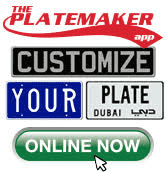Kansas License Plates
Cities and counties in Kansas started registering motor vehicles as early as 1904. Some of the cities and counties issued porcelain license plates while other required motor vehicle owners to get their own. The first statewide license plates were issued in 1913 and these were undated until 1921. The abbreviation KAN appeared on all state issued Kansas license plates until 1929 when the entire name KANSAS was embossed/stamped on all license plates. All state plates were made of steel or aluminum.
From 1949 through 1959, the license plates from Kansas were embossed/stamped with THE WHEAT STATE. The 1960 and 1961 Kansas license plates were embossed/stamped with CENTENNIAL 61 on bottom to mark one hundred years of statehood. Between 1965 and 1970, the slogan read MIDWAY, USA. Some of the Kansas license plates issued in 1974 and all of the 1975 issues were embossed/stamped with WHEAT CENTENNIAL along the bottom.
The 1942 Kansas license plates had colorful sunflower decals on the lower right and left corners. From 1951 through 1955, Kansas license plates were die cut in the shape of the state. In 1956, the United States Department of Transportation mandated all state license plates must be size inches by twelve inches. Kansas kept its unique license plate design by embossing the upper right border to resemble the map of the state. This design continued through 1976 and with decals this license plate issued was validated through 1980. The 1981 Kansas license plate had a screen print of wheat stalks from the bottom left. The state name was also screen on license plate. This is the first year state name KANSAS was not embossed/stamped. This license plate base was difficult for law enforcement to read and was replaced by the more legible retro-reflective white license plate base. The month of expiration was embossed on each license plate.
Reflective white paint was first used to coat embossed/stamped characters in 1964 and ended in 1976. Kansas introduced retro-reflective white sheeting on its license plates in 1981 and the use of retro-reflective sheeting continues today.




















